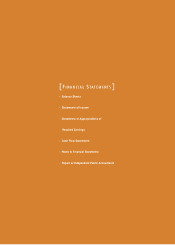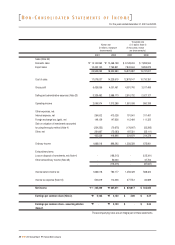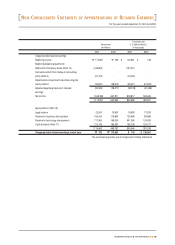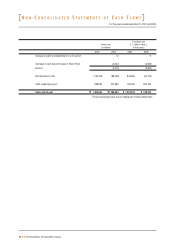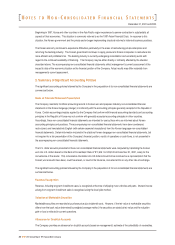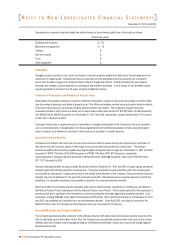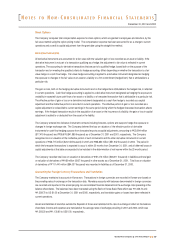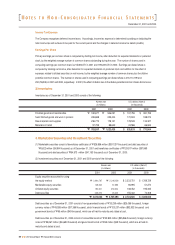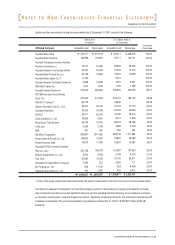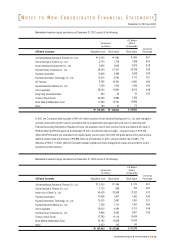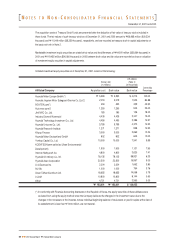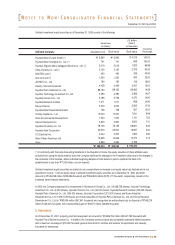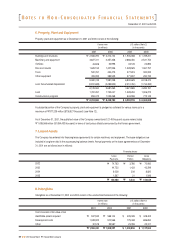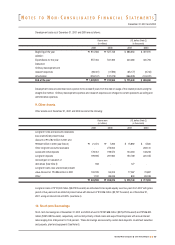Hyundai 2001 Annual Report Download - page 45
Download and view the complete annual report
Please find page 45 of the 2001 Hyundai annual report below. You can navigate through the pages in the report by either clicking on the pages listed below, or by using the keyword search tool below to find specific information within the annual report.
December 31, 2001 and 2000
Inventories
Inventories are stated at the lower of cost or net realizable value, cost being determined by the moving average cost method.
Valuation of Investment Securities
Equity securities held for investment (excluding those accounted for using the equity method discussed in the next paragraph)
that are not actively traded (unlisted securities) are stated at acquisition cost, as determined by the moving average method.
Actively quoted (listed) securities, including those traded over-the-counter, are stated at fair value, with the resulting valuation
gain or loss reported as a capital adjustment within shareholders’ equity. If the fair value of a listed equity security or the net
equity value of an unlisted security held for investment declines compared to acquisition cost and is not expected to recover
(impaired investment security), the carrying value of the equity security is adjusted to fair value or net equity value, with the
resulting valuation loss charged to current operations. If the net equity value or fair value subsequently recovers, in the case of
an unlisted security, the increase in value is recorded in current operations, up to the amount of the previously recognized
impairment loss, and in the case of a listed security, the increase in value is recorded in capital adjustments.
Equity securities held for investment that are in companies in which the Company is able to exercise significant influence over
the operating and financial policies of the investees are accounted for using the equity method. The Company’s share in the
net income or net loss of investees is reflected in current operations. Changes in the retained earnings, capital surplus or other
capital accounts of investees are accounted for as an adjustment to retained earnings or to capital adjustment.
Effective January 1, 2001, the Company changed its method for recognizing its share of the earnings of certain equity method
investees. Prior to 2001, the Company recognized earnings based on the financial statements of certain investees that were as
of a date one year prior to the date of the Company’s financial statements. Beginning with 2001, the Company recognizes
such earnings based on the financial statements of all investees which are as of the same date as the Company’s financial
statements. As a result of this change, beginning retained earnings at January 1, 2001, was charged "21,704 million ($16,367
thousand) representing the catch-up adjustment for the year 2000 accumulated losses of such investees which had not been
previously recognized by the Company. The impact of this change on the Company’s results of operations and financial
position for 2001 was to increase net income, capital adjustments, and deferred tax assets by "75,595 million ($57,006
thousand), "57,439 million ($43,314 thousand), and "21,606 million ($16,293 thousand), respectively. The Company also
recognized its share of other changes to the retained earnings of equity method investees which resulted in charges to
beginning retained earnings at January 1, 2000 and 2001, of "28,613 million ($21,576 thousand) and "33,831 million
($25,511 thousand), respectively.
Debt securities held for investment are classified as either held-to-maturity investment debt securities or available for sale
investment debt securities at the time of purchase. Held-to-maturity debt securities are stated at acquisition cost, as
determined by the moving average method. When the face value of a held-to-maturity investment debt security differs from its
acquisition cost, the effective interest method is applied to amortize the difference over the remaining term of the security.
Available-for-sale investment debt securities are stated at fair value, with the resulting valuation gain or loss reported as a
capital adjustment within shareholder’ equity. However, if the fair value of a held-to-maturity or an available-for-sale investment
debt security declines compared to the acquisition cost and is not expected to recover (impaired investment security), the
carrying value of the debt security is adjusted to fair value, with the resulting valuation gain or loss charged to current
operations. If the fair value of the security subsequently recovers, in the case of a held-to-maturity debt security, the increase in
value is recorded in current operations, up to the amount of the previously recognized impairment loss, and in the case of an
available-for-sale debt security, the increase in value is recorded in capital adjustments.
The lower of the acquisition cost of investments in treasury stock funds and the fair value of treasury stock included in a fund is
accounted for as gain or loss on valuation of treasury stock and reflected in capital adjustment.
Property, Plant and Equipment and Related Depreciation
Property, plant and equipment are stated at cost, except for the effects of any upward revaluations made in accordance with
the Asset Revaluation Law of Korea. Routine maintenance and repairs are expensed as incurred. Expenditures that result in
the enhancement of the value or extension of the useful lives of the facilities involved are treated as additions to property, plant
and equipment.
The Company capitalizes interest as part of the cost of constructing major facilities and equipment. Interest expense
capitalized in 2001 and 2000 was "74,353 million ($56,069 thousand) and "101,011 million ($76,171 thousand),
respectively.
N
OTES TO
N
ON
-C
ONSOLIDATED
F
INANCIAL
S
TATEMENTS
47
2001 Annual ReportHyundai Motor Company


